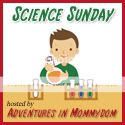I recently have been blessed to meet Janice van Cleave online! She has taken me under her wing and just sent us a box of many science experiments, several books, and lots of other science goodies. All of this came from a simple inquiry by me on a form from her website... she emailed me and we struck up a dialog about science!
The experiment she talked me through last week was Chameleon Pencils. My kids had gotten pencils before that changed colors based on heat and cold, but never understood why. The same concept applies to mood rings (which my daughter really likes!).
We took each pencil and stood it in a cup of warm water for 5 seconds. We found that the pencils got lighter when we did this (in the picture you can see what part of the pencil was in the water). Also, the pencils were then put into cold water for 5 seconds and they turned darker. My children had hypothesized that just the opposite would happen, so this was a great lesson for them!
These pencils have been painted with paint containing Leuco dyes, which is fully explained on Janice's website. I read this explanation to the children and they got it and thought it was "cool". Can't ask for more than that! Here's the simple explanation from Janice:
I encourage you to poke around Janice's website. She is a veteran science educator and author who truly wants to interact with homeschool moms! She wants children to learn why things happen, how they work, and to be fascinated with science -- not merely learn science from a textbook. I'm so glad I've met her and will be working with her!
*This post is linked to Science Sunday!




